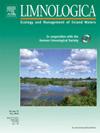Macroalgal (Spirogyra) nutrient and chlorophyll stoichiometric response to nutrient concentrations in a tropical river
IF 2
4区 环境科学与生态学
Q2 LIMNOLOGY
引用次数: 0
Abstract
A tenet of ecological stoichiometric theory is that autotroph stoichiometry is normally responsive to the variable supply of environmental resources of nutrients and light. The extent of autotroph stoichiometric plasticity is likely to vary with environmental resource variability, autotroph species, growth form and physiological needs. A field study was conducted in the Daly River catchment in the Australian wet/dry tropics to test the hypothesis that the carbon (C), nitrogen (N), phosphorus (P) and chlorophyll a (Chla) stoichiometry of the riverine, filamentous macroalga Spirogyra fluviatilis is responsive to concentrations of dissolved inorganic nitrogen (DIN), dissolved phosphorus and light, as well as temperature which can influence autotroph stoichiometry indirectly. Linear regressions were undertaken between stoichiometric dependent variables and independent environmental variables. With increased DIN concentrations, S. fluviatilis percentage content of N, C and Chla and molar N:P ratios increased, whilst C:Chla ratios decreased. No effect of light or temperature on algal stoichiometry was detected. The regressions, however, only explained one-third or less of S. fluviatilis stoichiometric variability, due most probably to methodological constraints, cell nutrient storage and uptake dynamics, and possibly undetected light and temperature effects. S. fluviatilis demonstrated N plasticity in response to DIN concentrations, to enrich the alga with N under relatively high DIN concentrations, enhancing its nutritional quality for herbivores and omnivores. This study complements others which have demonstrated macroalgal P plasticity. Stoichiometric variables can be used to monitor the impact of nutrient pollution and identify the stoichiometric basis for ecosystem-wide implications of nutrient pollution.
热带河流中大藻营养物和叶绿素对营养物浓度的化学计量学响应
生态化学计量理论的一个原则是,自养化学计量通常对环境中养分和光照资源的可变供应作出反应。自养生物的化学计量可塑性程度可能随环境资源的变化、自养生物种类、生长形式和生理需求而变化。在澳大利亚干湿热带地区的戴利河流域进行了一项实地研究,以验证河流丝状大藻(Spirogyra fluviatilis)的碳(C)、氮(N)、磷(P)和叶绿素A (Chla)的化学计量假设,这些假设对溶解无机氮(DIN)、溶解磷、光和温度的浓度有响应,这些浓度可以间接影响自养生物的化学计量。在化学计量学因变量和独立环境变量之间进行了线性回归。随着DIN浓度的增加,河螺中N、C、Chla的百分含量和摩尔N:P比值升高,C:Chla比值降低。没有发现光和温度对藻类化学计量的影响。然而,回归只解释了三分之一或更少的河螺化学计量变异性,这很可能是由于方法上的限制,细胞营养储存和摄取动力学,以及可能未检测到的光和温度的影响。S. fluviatilis对DIN浓度的响应表现出氮的可塑性,在较高的DIN浓度下为藻类富集氮,提高其对草食动物和杂食动物的营养品质。这项研究补充了其他已经证明大藻P可塑性的研究。化学计量变量可用于监测营养物污染的影响,并确定营养物污染对整个生态系统的影响的化学计量基础。
本文章由计算机程序翻译,如有差异,请以英文原文为准。
求助全文
约1分钟内获得全文
求助全文
来源期刊

Limnologica
环境科学-湖沼学
CiteScore
3.70
自引率
5.90%
发文量
64
审稿时长
3 months
期刊介绍:
Limnologica is a primary journal for limnologists, aquatic ecologists, freshwater biologists, restoration ecologists and ecotoxicologists working with freshwater habitats.
 求助内容:
求助内容: 应助结果提醒方式:
应助结果提醒方式:


